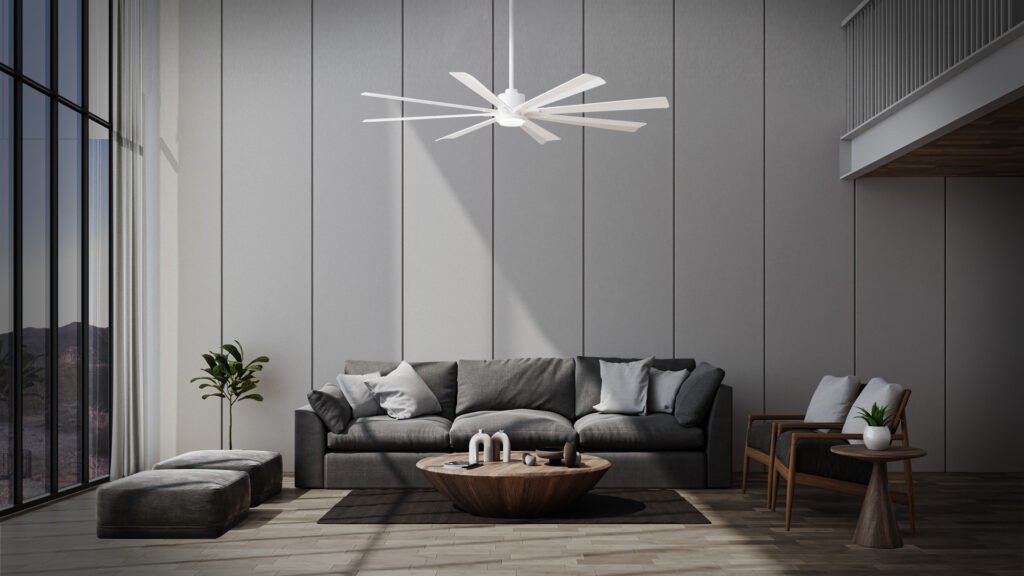Ceiling fans have been around for many years. They help cool rooms by moving the air. But now, we have smart ceiling fans. These fans can change how they work by themselves. They adjust to the room’s temperature and air quality without you touching them.
This article explains how smart ceiling fans work. You will learn how they know when to speed up or slow down. Also, you will see why these fans are useful in homes and offices.
What Makes a Ceiling Fan Smart?
A smart ceiling fan is different from a normal fan. It has sensors and a small computer inside it. These parts help the fan understand the room’s conditions.
Here are the main parts that make the fan smart:
- Temperature Sensors: These sensors check how hot or cold the room is.
- Humidity Sensors: They measure how much moisture is in the air.
- Motion Sensors: These detect if someone is in the room.
- Smart Controller: This is the brain of the fan. It decides how fast the fan should run.
How Do Smart Ceiling Fans Sense the Indoor Climate?
Smart fans use their sensors to watch the indoor climate. The temperature sensor checks how warm or cold the room is. If the room is too hot, the fan speeds up to cool it. If the room is cool, the fan slows down or stops.
Humidity sensors help the fan understand if the air feels wet or dry. High humidity can make a room feel hotter. The fan can increase airflow to make the air feel cooler.
Motion sensors tell the fan if someone is in the room. If the room is empty, the fan can turn off or run slowly. This saves energy.

Credit: www.amazon.com
How Does the Fan Decide the Best Speed?
The smart controller collects data from all sensors. It uses this data to choose the right fan speed. For example, if the room is hot and someone is there, the fan runs fast. If the room is cool and empty, it runs slow or stops.
Some fans also learn your habits. Over time, they remember when you like the fan on or off. This helps the fan work better for you.
Benefits of Automatic Climate Adjustment
Smart ceiling fans that adjust automatically have many good points. Here are some important benefits:
| Benefit | Why It Matters |
|---|---|
| Comfort | Keeps the room at the right temperature all day. |
| Energy Saving | Runs only when needed, using less electricity. |
| Convenience | No need to change fan speed by hand. |
| Better Air Quality | Helps reduce stuffy air and humidity. |
| Longer Fan Life | Runs less when not needed, so it lasts longer. |
How Smart Fans Work in Different Seasons
In summer, smart fans help cool your home. They speed up when the room is hot. This makes you feel cooler by moving air on your skin.
In winter, some smart fans can run slowly in reverse. This pushes warm air down from the ceiling. It helps keep the room warm and saves heating energy.
So, smart fans help all year round. They change how they work based on the season and room temperature.
Integration with Smart Home Systems
Many smart ceiling fans can connect to smart home systems. You can control them with your phone or voice.
For example, you can:
- Turn the fan on or off remotely.
- Set schedules for the fan to run.
- Link the fan to other devices like air conditioners.
This makes your home more comfortable and easier to manage.
Installation and Setup
Installing a smart ceiling fan is similar to a regular fan. But it may need a Wi-Fi connection to work properly.
Most smart fans come with an app. You use this app to set up the fan. It guides you through connecting the fan to your home network.
After setup, the fan begins to monitor the room and adjust itself.

Credit: cielowigle.com
Common Questions About Smart Ceiling Fans
People often ask about the fan’s noise, cost, and energy use. Here are simple answers:
- Are smart fans noisy? No, most smart fans are quiet.
- Are they expensive? They cost more than regular fans but save money on energy.
- Do they use more electricity? No, they often use less electricity because they run only when needed.
Future of Smart Ceiling Fans
Smart ceiling fans will keep getting better. New models will have more sensors and smarter controls.
They may also learn more about your habits and weather outside. This will help them adjust even better.
In time, smart fans will be a common part of smart homes.
Summary
Smart ceiling fans change speed automatically. They use sensors to check temperature, humidity, and motion.
The fan’s controller decides how fast to run. It keeps the room comfortable and saves energy.
Smart fans work in all seasons and can connect to smart home systems. They are easy to install and use.
In short, smart ceiling fans help make your home nicer to live in, without much work from you.
Frequently Asked Questions
How Do Smart Ceiling Fans Detect Indoor Temperature?
Smart fans use built-in sensors to measure room temperature constantly.
Can Smart Ceiling Fans Adjust Speed Automatically?
Yes, they change fan speed based on the room’s current climate.
Do Smart Fans Save Energy Compared To Regular Fans?
Smart fans use energy efficiently by running only as needed.
What Role Do Humidity Sensors Play In Smart Fans?
Humidity sensors help fans adjust airflow for better comfort.

